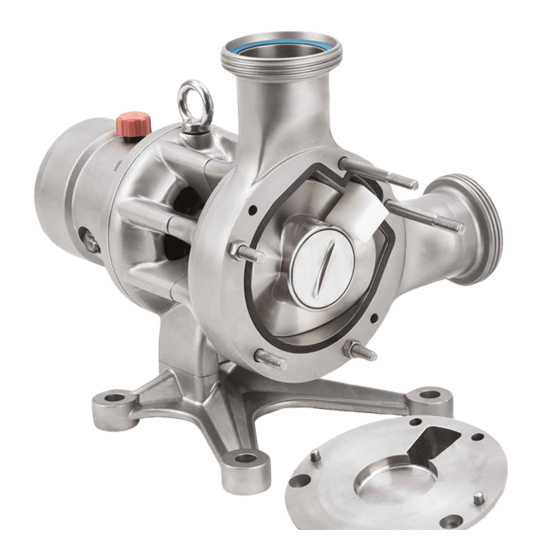
Summarization of Contents
Safety Notes and Precautions
Obligation of the Operating Organisation
Ensures personnel are familiar with and comply with safety and accident prevention regulations.
Organisational Measures for Safety
Operating organisation must provide PPE and regularly check safety devices.
Obligation of the Operators
Operators must observe safety regulations, read safety chapter and warning notes.
Personnel Training Requirements
Only trained people may work on the machine; responsibilities must be clear.
General Safety Measures
Operating instructions must be kept with machine; regulations must be observed.
Dangers When Handling the Machine
Danger to life, limb, or machine can arise; use only for intended use and safe condition.
Safety Measures in Normal Operation
Operate only if protective devices function; check for damage and function before start.
Protective Devices
Protective devices must be attached and functioning before start-up; re-attach after spare parts.
Dangers Due to Hazardous Pumped Material
Appropriate regulations must be observed if hazardous material is pumped.
Dangers Due to Electrical Energy
Electrical work only by electrician; check equipment regularly.
Dangers Due to Hydraulic Energy
Personnel with hydraulics knowledge only; relieve pressure before repair.
Special Danger Points
Caution regarding rotating rotor, crushing fingers/hands; guard pump.
Constructional Changes to the Machine
No changes without manufacturer's approval; use only original spare parts.
Noise Levels and Precautions
Sound pressure level should not exceed 70 dB(A); use protective equipment if higher.
Limit Values for the Pump
Maximum speed, pressure, temperature must not be exceeded.
Maintenance and Repair Procedures
Work carried out by trained personnel; secure machine before work.
Cleaning the Pump
Handle substances and materials correctly, especially when cleaning with solvents.
Fault Identification and Rectification
If fault occurs, switch off and secure machine against unintentional start-up.
Pump Specifications
Applicable Standards
Standards applicable to the pump connected to a drive.
Pump Dimensions
Provides detailed dimensions in millimeters and inches.
Unit Weights
Specifies pump and baseplate weights.
Good Pump Installation Practice
Installation Dos and Don'ts
Guidelines on proper installation, pipework, and suction/delivery.
Connection to the Piping
Instructions for connecting piping, avoiding forces, and pressure management.
Cavitation Avoidance
Explains cavitation, how to identify it, and how to avoid or remove it.
Possible Pump Orientations
Details the eight possible pump positions and self-draining requirements.
Connecting to Power Supply
Motor connection must follow local regulations by a qualified person.
Flushing the Seal System
Dynamic Flushing Procedure
Describes dynamic flushing using a tube connected to the flush system.
Static Flushing Device
Instructions for fitting and removing the static flushing device.
Fitting a Flush Ring
Refers to assembly instructions for fitting a flush ring.
Cleaning and Sterilisation
Clean-in-Place (CIP) Procedure
Details the clean-in-place procedure, including fluids and parameters.
Steam-in-Place (SIP) Procedure
Explains steam sterilization process and safety information.
Key CIP and SIP Safety Information
Safety guidelines for CIP and SIP processes, distance, monitoring.
Aseptic Processing System Requirements
Requirements for aseptic systems and pressure monitoring.
Changing the Pump Oil
Oil Filling Volumes
Specifies the oil filling volumes for the C800 model.
Troubleshooting
Technical Support Contact
Provides contact information for technical support via website.
Disassembly and Assembly
Removing the Front Housing
Step-by-step guide to removing the pump's front housing.
Removing the Locking Screw
Instructions for removing the locking screw using a blocking tool.
Removing the Rotor and Gate
Steps to remove the rotor and gate, including shaft extensions.
Removing the Seal System
Steps to carefully remove the seal system and O-ring.
Removing the Spring Assembly
Instructions for removing the spring assembly from the back housing.
Disassembling the Middle Housing
Explains how to disassemble the middle housing for completeness.
Disassembling the Support Unit
Steps to disassemble the support unit by undoing screws.
Changing the Nozzle Orientation
Instructions for changing the nozzle orientation by undoing screws.
Assembling Support and Centering Rotor
How to place shim rings and tighten screws for support assembly.
Checking and Adjusting X-Dimension
Measuring the X-Dimension and adjusting with shim rings if needed.
Assembling the Front Mechanical Seal
Steps to install the spring assembly and O-ring into the housing.
Fitting the Rotor Seal System
Instructions for fitting the seal face and rubber cup onto the rotor.
Assembling the Pump Head
Steps to assemble the middle housing and front housing.
Assembling Rotor and Gate
How to assemble the rotor and gate on the shaft and fasten fixation plate.
Assembling the Front Housing
Steps to fit the seal in the middle housing and attach the front housing.
Assembling Flush Ring (Single Seal)
Instructions for assembling the flush ring with lip seal and O-ring.
Assembling Back Seal (Double Seal)
Shows component parts of the back seal assembly.
Parts Lists
Pump Component List
Detailed breakdown of pump components with part numbers.
Optional Parts List
Lists optional components such as single mechanical seals and flush rings.
Tools List
Lists essential tools like blocking tools, lifting devices, and socket adapters.










Need help?
Do you have a question about the Certa 400 and is the answer not in the manual?
Questions and answers